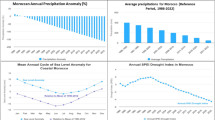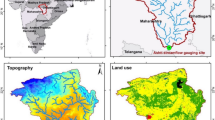Abstract
In order to predict long-term flooding under extreme weather conditions in central Asia, an energy balance-based distributed snowmelt runoff model was developed and coupled with the Soil and Water Assessment Tool (SWAT) model. The model was tested at the Juntanghu watershed on the northern slope of the TianShan Mountains, Xinjiang, China. We compared the performances of temperature-index method and energy balanced method in SWAT model by taking Juntanghu river basin as an application example (as the simulation experiment was conducted in Juntanghu River, we call the energy balanced method as SWAT-JTH). The results suggest that the SWAT snowmelt model had overall Nash-Sutcliffe efficiency (NSE) coefficients ranging from 0.61 to 0.85 while the physical based approach had NSE coefficients ranging from 0.58 to 0.69. Overall, on monthly scale, the SWAT model provides better results than that from the SWAT-JTH model. However, results generated from both methods seem to be fairly close at a daily scale. The structure of the temperature-index method is simple and produces reasonable simulation results if the parameters are well within empirical ranges. Although the data requirement for the energy balance method in current observation is difficult to meet and the existence of uncertainty is associated with the experimental approaches of physical processes, the SWAT-JTH model still produced a reasonably high NSE. We conclude that using temperature-index methods to simulate the snowmelt process is sufficient, but the energy balance-based model is still a good choice to simulate extreme weather conditions especially when the required data input for the model is acquired.
Similar content being viewed by others
References
Abbaspour KC, Vejdani M, Haghighat S (2007) SWAT-CUP calibration and uncertainty programs for SWAT. In: Oxley L, Kulasiri D (eds.), MODSIM 2007 International Congress on Modelling and Simulation. Modelling and Simulation Society of Australia and New Zealand, December 2007. pp 1596–1602.
Ahmad HMN, Sinclair A, Jamieson R, et al. (2011) Modeling sediment and nitrogen export from a rural watershed in Eastern Canada using the soil and water assessment tool. Journal of Environmental Quality 40: 1182–1194. DOI: 10.2134/jeq2010.0530
Albert M, Krajeski G (1998) A fast, physically based point snowmelt model for use in distributed applications. Hydrological Processes 12: 1809–1824. DOI: 10.1002/(SICI)1099-1085(199808/09)12:10/11
Allen RG, Pereira LS, Raes D, et al. (1998) Crop evapotranspiration. Guidelines for computing crop water requirements. Irrigation and Drainage Paper. Rome, Italy (No. 56, FAO, Rome). pp 300.
Anderson EA (1976) A point energy and mass balance model of a snow cover. Silver Spring, MD US. National Oceanic and Atmospheric Administration (NOAA), Technical Report NWS 19.
Bathurst JC, Cooley KR (1996) Use of the SHE hydrological modelling system to investigate basin response to snowmelt at Reynolds Creek, Idaho. Journal of Hydrology 175: 181–211. DOI: 10.1016/S0022-1694(96)80011-4
Bingner RL (1996) Runoff simulated from Goodwin Creek watershed using SWAT Transactions of the ASAE 39:85–90. DOI: 10.13031/2013.27483
Bristow KL, Campbell GS, Saxton KE (1985) An equation for separating daily solar irradiation into direct and diffuse components. Agricultural and Forest Meteorology 35:123–131. DOI: 10.1016/0168-1923(85)90079-6
Braithwaite RJ (1995) Positive degree-day factors for ablation on the Greenland ice sheet studied by energy-balance modelling. Journal of Glaciology 41(137):153–160.
Casoria F, Dalla Fontana G (1996) Snowmelt modelling by combining air temperature and a distributed radiation index. Journal of Hydrology 181: 169–187. DOI: 10.1016/0022-1694(95) 02913-3
Chen XF, Tian J, Zhang XP, et al. (2006) An Overview of the Researches on the Coupled Transport of Water, Heat and Solute in the Accumulating and Melting Processes of Snowpack. Jouranl of Glaciology and Geocryology 28: 288–292. DOI: 10.3969/j.issn.1000-0240.2006.02.021
Chow VT, Maidment DR, Mays LW (1998) Applied Hydrology. McGraw — Hill Book Co., Inc., New York, N.Y. pp 570.
Chu TW, Shirmohammadi A (2004) Evaluation of SWAT model’s hydrology component in the Piedmont Physiographic Region of Maryland. Transactions of the ASAE 47: 1057–1073.
Cline DW (1997) Snow surface energy exchanges and snowmelt at a continental, midlatitude alpine site. HYPERLINK “http://agupubs.onlinelibrary.wiley.com/agu/journal/10.1002/%28ISSN%291944-7973/”\t“_blank” Water Resources Research 33(4): 689–701. DOI: 10.1029/97WR00026
Colbeck SC (1972) A theory of water percolation in snow. Journal of Glaciology 11: 369–385.
Debele B, Srinivasan R, Gosain AK (2010) Comparison of Process-Based and Temperature-Index Snowmelt Modeling in SWAT. Water Resource Management 24:1065–1088. DOI:10.1007/s11269-009-9486-2
Dornes PF, Pomeroy JW, Pietroniro A, et al. (2008) Influence of landscape aggregation in modelling snow-cover ablation and snowmelt runoff in a sub-arctic mountainous environment. Hydrological Sciences Journal/Journal des Sciences Hydrologiques 53: 725–740. DOI: 10.1623/hysj.53.4.725
FAO, IIASA, ISRIC, et al. (2009) Harmonized World Soil Database (version 1.1). FAO, Rome, Italy and IIASA, Laxenburg, Austria.
Fernández A (1998) An energy balance model of seasonal snow evolution. Physics and Chemistry of the Earth 23: 661–666. DOI: 10.1016/S0079-1946(98)00107-4
Gitau MP, Gburek W, Jarrett AP (2002) Estimating best management practice effects on water quality in the town brook watershed, New York, Federal Interagency Hydrologic Modeling Conference, New York. pp 1–12.
Hock R (2003) Temperature index melt modeling in mountain areas. Journal of Hydrology 282:104–115. DOI: 10.1016/S0022-1694(03)00257-9
Horton RE (1915) The melting of snow. Monthly Weather Review 43: 599–605. DOI: 10.1175/1520-0493(1915)43 〈599:TMOS〉2.0.CO;2
Jin J, Gao X, Yang ZL, et al. (1999) Comparative Analyses of Physically Based Snowmelt Models for Climate Simulations. Journal of Climate 12: 2643–2657. DOI: 10.1175/1520-0442(1999)012
Johnson KH (1977) A predictive method for ground water levels. Cornell University, New York.
Koivusalo H, Kokkonen T (2002) Snow processes in a forest clearing and in a coniferous forest. Journal of Hydrology 262: 145–164. DOI:10.1016/S0022-1694(02)00031-8
LaMalfa EM, Ryle R (2008) Differential snowpack accumulation and water dynamics in aspen and conifer communities: implications for water yield and ecosystem function. Ecosystems 11: 569. DOI: 10.1007/s10021-008-9143-2
Li L, Simonovic SP (2002) System dynamics model for predicting floods from snowmelt in North American prairie watersheds. Hydrological Processes 16(13): 2645–2666. DOI: 10.1002/hyp.1064
Marks D, Domingo J, Susong D, et al. (1999) A spatially distributed energy balance snowmelt model for application in mountain basins. Hydrological Processes 13: 1935–1959. DOI: 10.1002/(SI-CI)1099-1085(1999-09)13:12/13
Marks D, Kimball J, Tingey D, et al. (1998) The sensitivity of snowmelt processes to climate conditions and forest cover during rain-on-snow: a case study of the 1996 Pacific Northwest flood. Hydrological Processes 12: 1569–1587. DOI: 10.1002/(SICI)1099-1085(199808/09)12:10/11
Martinec J, Rango A, Roberts RT (2008) Snowmelt Runoff Model (SRM) User’s Manual New Mexico State University, Las Cruces, New Mexico. pp 175.
Moriasi DN, Arnold JG, Van liew MW, et al. (2007) Model evaluation guidelines for systematic quantification of accuracy in watershed simulations. Trans ASABE 50: 885–900.
Morid S, Gosain A, Keshari A (2001) Challenges in snowmelt runoff simulation. Journal of the Earth and Space Physics 27: 11–20.
Morid S, Gosain A, Keshari A (2002) Solar radiation estimation using temperature-based stochastic and artificial neural networks approaches. Nordic Hydrology 33: 291–304. DOI: 10.2166/nh.2002.016
Morris EM, Godfrey J (1979) The European hydrologic system snow routine. In: Modelling of Snow Cover Runoff (ed. by S.C. Colbeck and M. Ray, Proc. Meeting, Hanover, New Hampshire, Sept. 1978), US Army Cold Regions Research and Engineering Laboratory. pp 269–278.
Nash JE, and Sutcliffe RM (1970) River flow forcasting through conceptual models: Part 1. A discussion of principles. Journal of Hydrology 10: 282–290. DOI: 10.1016/0022-1694(70)90255-6
Neitsch SL, Arnold JG, Kiniry JR, et al. (2001) Soil and water assessment tool (SWAT) theoretical documentation. Black Land Research Center, Texas Agricultural Experiment Station, pp. TX. p 781.
Neitsch SL, Arnold JG, iniry JR, et al. (2005) “Soil and Water Assessment Tool Theoretical Documentation-Version 2005,” Soil and Water Research Laboratory, Agricultural Research Service, US Department of Agriculture, Temple.
Rango A, Martinec J (2008) Predictions for snow cover, glaciers and runoff in a changing climate. In: Hydrology and Water Resources International Conference Proceedings, Prague, Czech Republic. pp 277–280.
Rosenthal WD, Srinivasan R, Arnold JG (1995) Alternative river management using a linked GIS-hydrology model. Transactions of the ASAE 38:783–790. DOI: 10.13031/2013.27892
Santhi C, Arnold JG, Williams JR, et al. (2001) Application of a watershed model to evaluate management efforts on point and nonpoint source pollution. Transactions of the ASAE 44:1559–1570.
Sangrey DA, Harrop-Williams KO, Klaiber JA (1984) Predicting groundwater response to precipitation. Journal of Geotechnical Engineering 110: 957–975. DOI: 10.1061/(ASCE)0733-9410(1984)110:7(957).
Schaefli B, Gupta H V (2007) Do Nash values have value? Hydrological Processes 21:2075–2080. DOI: 10.1002/hyp.6825
Sokratov SA, Maeno N (1997) Heat and mass transport in snow under a temperature gradient. In: Izumi M, Nakamura TS, Sack RL (eds.), Snow Engineering: Recent Advances (Proceedings of the Third International Conference on Snow Engineering, Sendai, Japan, May 1996). A. A. Balkema Publishers, Rotterdam, Netherlands. pp 49–54.
Sophocleous MA, Koellikerb J.K, Govindaraju R.S, et al. (1999) Integrated numerical modeling for basin-wide water management: The case of the Rattlesnake Creek basin in south-central Kansas. Journal of Hydrology 214: 179–196. DOI: 10.1016/S0022-1694(98)00289-3
Spruill CA, Workman RS, TAraba J (2000) Simulation of daily and monthly stream discharge from small watersheds using the SWAT model. Transactions of the ASAE 43: 1431–1439.
Tarboton DG (1994) Measurements and modeling of snow energy balance and sublimation from snow. Utah.
Tetens O (1930) Ueber einige meteorologische Begriffe [“About some meteorological terms”]. Journal of Geophysics 6: 297–309.
Todini E (1996) The ARNO rainfall runoff model. Journal of Hydrology 175: 339–382. DOI: 10.1016/S0022-1694(96)800163
Tuteja NK, Cunnane C (1997) Modelling coupled transport of mass and energy into the snowpack-model development, validation and sensitivity analysis. Journal of Hydrology 195: 232–255. DOI: 10.1016/S0022-1694(96)03236-2
Valeo C, Ho CLI (2004) Modelling urban snowmelt runoff. Journal of Hydrology 299: 237–251. DOI: 10.1016/j.jhydrol.2004.08.007
Van Liew MW, Garbrecht J (2003) Hydrologic simulation of the little Washita river experimental watershed using SWAT. Journal of the American Water Resources Association 39: 413–426. DOI:10.1111/j.1752-1688.2003.tb04395.x
Weber A, Nicola F, Moller D (2001) Long-term land use changes in a mesoscale watershed due to socio-economic factors-effects on landscape structures and functions. Ecological Modelling 140: 125–140. DOI: 10.1016/S0304-3800(01)00261-7
Yao H-X, McConnell C, James A, Fu CS (2012) Comparing and Modifying Eight Empirical Models of Snowmelt Using Data from Harp Experimental Station in Central Ontario. British Journal of Environment and Climate Change 2: 259–277. DOI: 10.9734/BJECC/2012/2249
Zhang C, Zheng Y (2005) Extraction of hydrological information from digital elevation model with ArcGIS9.0. China Academic Journal Electronic Publishing House 36: 1–4. (In Chinese)
Zhang YC, Li BL, Bao AM, et al. (2007) Study on snowmelt runoff simulation in the Kaidu River basin. Science in China Series D: Earth Sciences 50: 26–35. DOI: 10.1007/s11430-007-5007-4
Zhao QD, Liu ZH, Qin RM, et al. (2007) Research Advance of Snowmelt Model. Xinjiang Agricultural Sciences 44: 734–739. (In Chinese)
Zhao Q, Liu Z, Ye B, et al. (2009) A snowmelt runoff forecasting model coupling WRF and DHSVM. Hydrology and Earth System Sciences 13: 1897–1906. DOI: 10.5194/hessd-6-3335-2009
Author information
Authors and Affiliations
Corresponding author
Rights and permissions
About this article
Cite this article
Meng, XY., Yu, DL. & Liu, ZH. Energy balance-based SWAT model to simulate the mountain snowmelt and runoff — taking the application in Juntanghu watershed (China) as an example. J. Mt. Sci. 12, 368–381 (2015). https://doi.org/10.1007/s11629-014-3081-6
Received:
Accepted:
Published:
Issue Date:
DOI: https://doi.org/10.1007/s11629-014-3081-6




